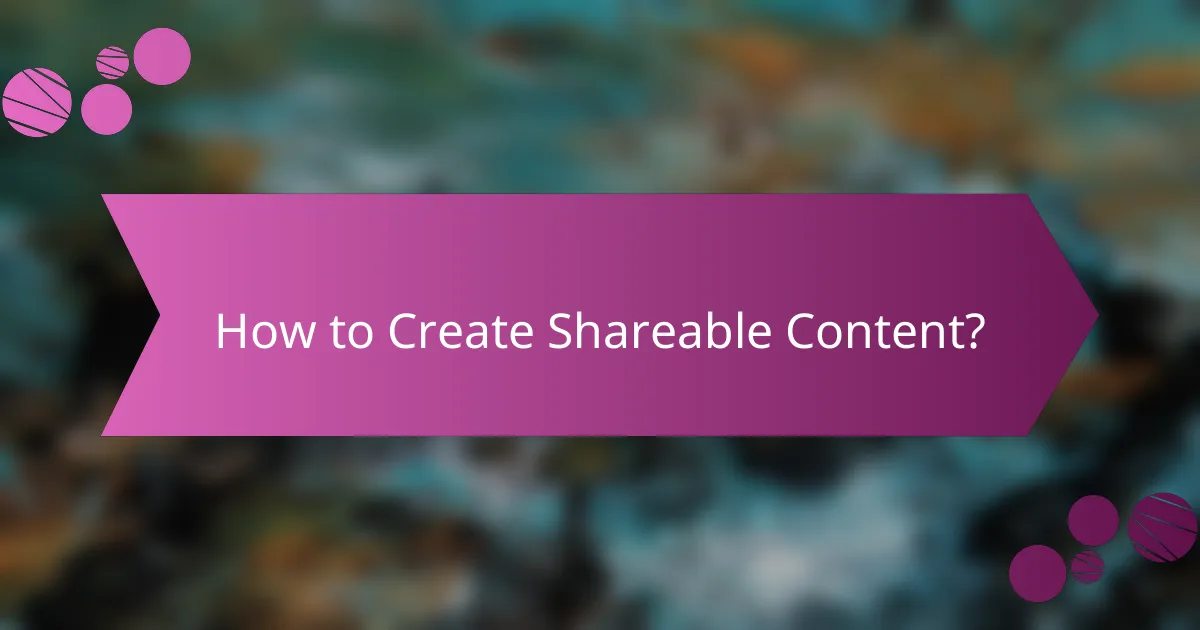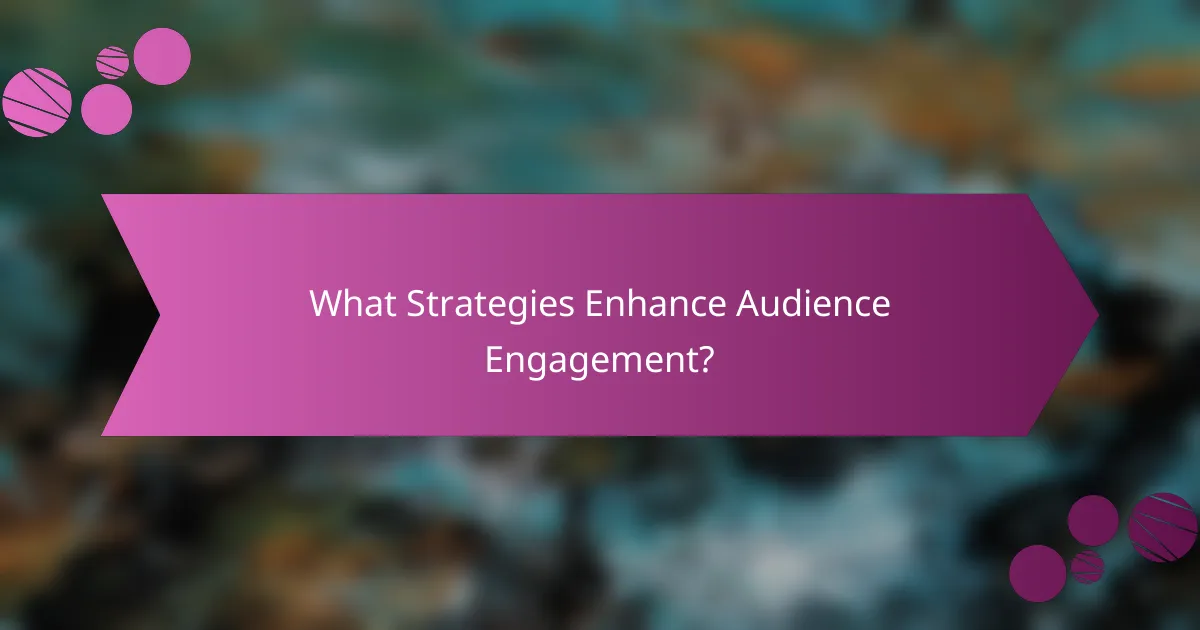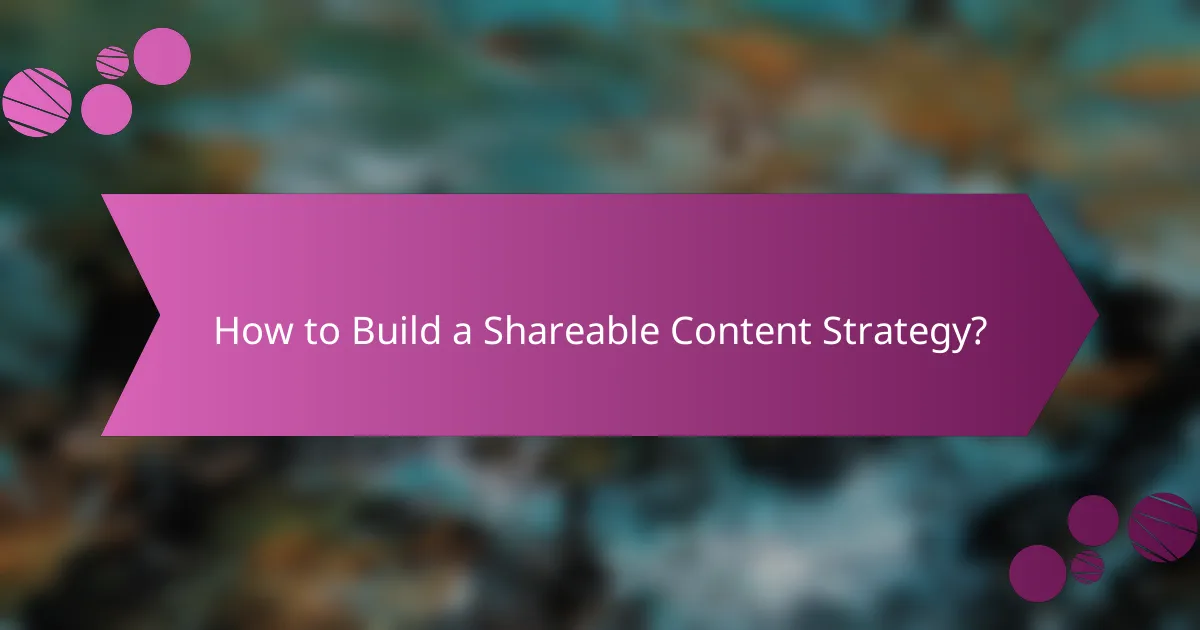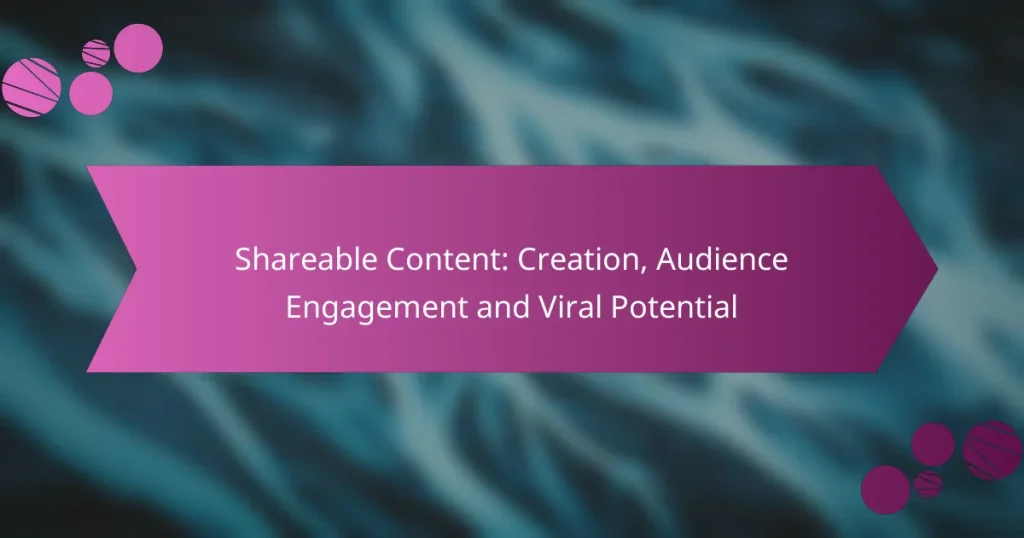Creating shareable content is essential for maximizing audience engagement and achieving viral potential. By focusing on storytelling, compelling visuals, and current trends, content can resonate deeply with users, prompting them to share it within their networks. Techniques that promote interactivity and personalization further enhance audience connection, making it more likely for content to be widely disseminated.

How to Create Shareable Content?
Creating shareable content involves crafting engaging material that resonates with your audience, encouraging them to share it within their networks. Key elements include storytelling, visuals, user involvement, social optimization, and relevance to current trends.
Focus on storytelling
Storytelling is a powerful tool for creating shareable content as it connects emotionally with the audience. A compelling narrative can make your message memorable and relatable, increasing the likelihood of sharing.
Consider structuring your content around a central theme or character that your audience can identify with. Use anecdotes or case studies to illustrate your points, making the content more engaging and easier to share.
Use engaging visuals
Visuals significantly enhance the shareability of content by making it more appealing and easier to digest. Infographics, videos, and striking images can convey complex information quickly and attractively.
Ensure that your visuals are high-quality and relevant to the content. Tools like Canva or Adobe Spark can help create professional-looking graphics that enhance your message and encourage sharing.
Incorporate user-generated content
User-generated content (UGC) fosters community and trust, making it a valuable addition to shareable content. Encouraging your audience to contribute their own experiences or insights can create a sense of ownership and increase engagement.
Consider running contests or campaigns that invite users to share their content related to your brand. Highlighting UGC on your platforms not only enriches your content but also motivates others to participate.
Optimize for social sharing
To maximize the shareability of your content, optimize it for social media platforms. This includes using appropriate formats, such as square images for Instagram or short videos for TikTok, and crafting catchy headlines that grab attention.
Incorporate social sharing buttons on your website to make it easy for users to share your content. Additionally, consider including a call-to-action that encourages sharing, such as “Share this with your friends!”
Leverage trending topics
Creating content around trending topics can significantly boost its shareability. By tapping into current events or popular discussions, you can attract a wider audience and increase engagement.
Use tools like Google Trends or social media hashtags to identify what’s currently popular. Ensure that your content adds value to the conversation, whether through insights, humor, or unique perspectives, to encourage sharing.

What Strategies Enhance Audience Engagement?
Enhancing audience engagement involves using techniques that actively involve users and encourage interaction. By focusing on interactivity, feedback, personalization, and live experiences, content creators can significantly boost audience participation and connection.
Utilize interactive elements
Interactive elements, such as polls, quizzes, and surveys, can greatly enhance audience engagement. These tools invite users to participate actively rather than passively consuming content, making the experience more memorable.
Consider incorporating features like clickable infographics or gamified content that rewards users for their participation. This not only keeps users engaged but can also provide valuable insights into their preferences and interests.
Encourage comments and feedback
Inviting comments and feedback fosters a sense of community and belonging among your audience. This can be achieved by asking open-ended questions at the end of your content or creating dedicated spaces for discussion.
Responding to comments promptly can further enhance engagement, as it shows that you value your audience’s opinions. Consider setting aside time each week to engage with your audience’s feedback actively.
Implement personalized content
Personalized content tailors the user experience based on individual preferences, behaviors, or demographics. By analyzing user data, you can create targeted content that resonates more deeply with specific audience segments.
For instance, using email marketing to send personalized recommendations can increase open rates and conversions. Tools like segmentation and dynamic content can help you deliver the right message to the right audience at the right time.
Host live events or webinars
Live events and webinars provide a unique opportunity for real-time interaction, allowing audiences to engage directly with content creators. These formats encourage questions and discussions, making the experience more dynamic and engaging.
To maximize participation, promote your events across social media and email channels. Consider offering incentives, such as exclusive content or discounts, to encourage sign-ups and attendance.

What Factors Contribute to Viral Potential?
Viral potential is influenced by several key factors that enhance content’s ability to be widely shared and engaged with. Understanding these elements can help creators design content that resonates with audiences and encourages sharing.
Emotional resonance
Emotional resonance refers to the ability of content to evoke strong feelings in its audience, such as joy, surprise, or even anger. Content that stirs emotions is more likely to be shared, as people often want to connect others with their feelings. For instance, heartwarming stories or humorous videos tend to perform well because they trigger relatable emotions.
To maximize emotional impact, consider using storytelling techniques that highlight personal experiences or relatable scenarios. Aim for authenticity; audiences can often sense when emotions are genuine, which enhances the likelihood of sharing.
Shareability on social media
Shareability is the ease with which content can be distributed across social media platforms. Content designed for shareability often includes engaging visuals, concise messaging, and clear calls to action. Infographics, memes, and short videos are examples of formats that typically encourage sharing.
When creating shareable content, ensure it is optimized for various platforms. For example, vertical videos work well on TikTok, while square images are ideal for Instagram. Additionally, incorporating hashtags can increase visibility and encourage sharing among specific communities.
Influencer partnerships
Partnering with influencers can significantly boost a piece of content’s viral potential. Influencers have established trust and a loyal following, making their endorsement valuable for reaching wider audiences. Collaborating with influencers who align with your brand can enhance credibility and increase engagement.
To leverage influencer partnerships effectively, choose influencers whose audience matches your target demographic. Consider offering them exclusive content or incentives to share, which can further motivate them to promote your material.
Timing and relevance
Timing and relevance are critical for maximizing the impact of content. Content that aligns with current events, trends, or cultural moments is more likely to capture attention and be shared. For example, a video that addresses a trending topic or a seasonal event can resonate more with audiences.
To optimize timing, monitor social media trends and news cycles. Tools like Google Trends can help identify what topics are currently popular. Additionally, consider scheduling posts during peak engagement times for your target audience, which can vary by platform and demographic.

What Metrics Measure Shareable Content Success?
Measuring the success of shareable content involves analyzing various metrics that indicate how well the content resonates with the audience. Key metrics include social shares and likes, engagement rates, traffic sources, and conversion rates, each providing insights into different aspects of content performance.
Social shares and likes
Social shares and likes are fundamental indicators of how widely content is being distributed across social media platforms. High numbers of shares suggest that the content is engaging and relevant to the audience, prompting them to share it with their networks.
To maximize shares, create content that evokes strong emotions or provides valuable information. Content that is visually appealing or includes interactive elements often sees higher share rates. Aim for a target of at least a few dozen shares for smaller audiences and hundreds for larger ones.
Engagement rate
The engagement rate measures the level of interaction users have with your content, including comments, likes, shares, and time spent on the page. A high engagement rate indicates that the audience finds the content compelling and is willing to interact with it.
To improve engagement, focus on creating relatable and thought-provoking content. A good benchmark for engagement rates on social media is around 1-5%, but this can vary significantly by platform and industry. Regularly analyze which types of content generate the most engagement to refine your strategy.
Traffic sources
Traffic sources reveal where your audience is coming from, helping you understand which channels are most effective for distributing your content. Analyzing traffic sources can guide future content promotion efforts and highlight successful platforms.
Utilize tools like Google Analytics to track traffic sources and identify trends. Focus on optimizing content for the channels that drive the most traffic, whether that’s social media, email newsletters, or search engines. A balanced approach across multiple channels typically yields the best results.
Conversion rates
Conversion rates measure the percentage of users who take a desired action after engaging with your content, such as signing up for a newsletter or making a purchase. High conversion rates indicate that your content not only attracts attention but also drives action.
To enhance conversion rates, ensure that your content includes clear calls to action (CTAs) and aligns with user intent. A typical conversion rate goal is around 2-5%, but this can vary based on industry and audience. Regularly test different CTAs and content formats to find what resonates best with your audience.

How to Build a Shareable Content Strategy?
To build a shareable content strategy, focus on creating engaging and relevant content that resonates with your audience. Understanding your target audience and leveraging their preferences will enhance the likelihood of your content being shared.
Define target audience
Defining your target audience is crucial for creating shareable content. Start by identifying demographics such as age, gender, location, and interests. This information helps tailor your content to meet their specific needs and preferences.
Consider using tools like surveys, social media analytics, and market research to gather insights about your audience. Segmenting your audience into smaller groups can also help you create more personalized content that encourages sharing.
Once you have a clear understanding of your target audience, develop content that addresses their pain points or interests. For example, if your audience is primarily young professionals, focus on topics like career development, productivity tips, or work-life balance to increase engagement and sharing potential.

